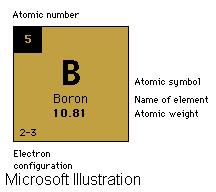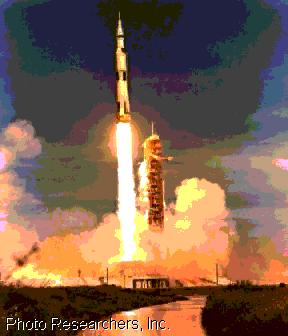THE AMERICAN UNIVERSITY
IN CAIRO
Engineering Department
Strength and Testing of Materials
Application Project
Boron in Materials Technology
Based on its applications in the Ceramics industry
Presented to:
Dr. Mohamed Nagib Abou-Zeid
Presented by:
Moataz Mohammad Attallah
I-Abstract:
The aim of this application project is to introduce a complete
outline for the emerging uses of Boron in materials technology. The project
traces some of the important facts about Boron, such as: chemical and material
properties, preparation from its ores, its important compounds, and its
practical applications. The report relates the material properties of Boron
with its new applications in the field of Ceramics. The report also defines
ceramics and several kinds. Included with the report and index containing
data about Boron, in addition to list of its physical, chemical and material
properties.
Table of Contents:
I-Abstract 1
II-Material Properties 2
III-Boron 3-5
a-Chemical Properties 3
b-Physical Properties 3
c-Ores 4
d-Compounds 4
e-Applications 5
IV-Ceramics 6
a-Introduction 6
b-Definition 6
c-Types of Ceramics 6
d-Applications 7
V-References 8
II-Material Properties:
Boron Physical or Chemical Property Value
Atomic Number 5
Mass Number 10.811
Specific Gravity 2.46
Melting Point 2,180°C (3,956°F)
Boiling Point 3,650°C (6602°F)
Young’s Modulus 1.3 GPA
Shear’s Modulus 0.65 GPA
Poisson’s Ratio 0.02 (approx.)
Molar Volume 4.39 Cm3
Hardness (Moh’s scale) 9.3
Hardness (Vickers) 49000 MN/m2
Bulk’s Modulus 8.3 GPA
III-Boron:
a-Introduction.
b-Chemical properties.
c-Physical properties.
d-Ores.
e-Compounds
f-Applications in Aerospace industry and tennis rackets industry.
Since World War II, the field of boron chemistry has grown rapidly
because of interest in the chemical similarities of boron to carbon and
silicon. For example, boron forms covalent bonds with itself and with certain
other elements, much as do carbon and silicon. That is why it has emerged
lately in materials technology as an important element that might be used
in producing some types of Ceramics and strengthening some materials like
steel and aluminum.
Boron, symbol B-with an atomic number of 5 and mass number of
10.811, is a hard and brittle material. Its position in the periodic table
is in group (IIIA), which is the same group of Aluminum with a valence
of 3. It was supposed to have materials properties similar to those of
Aluminum, however its properties tend to be more like the semi-metallic
properties of Carbon and Silicon.
Boron, in its compounds, tends to behave like non-metals.
However, opposing all non-metals, Boron is an electric conductor, like
the metals and Carbon(graphite) as well.
Pure Boron has a Crystalline appearance (Icosahedral ), similar
to diamond, and is almost as hard as it. It is usually prepared in an amorphous
powder. A crystalline form is prepared by dissolving boron in molten Aluminum,
and cooling slowly. Pure Boron melts at about 2180° C (3956° F),
and boils at 3650° C (6602° F). Its specific gravity is 2.46.
In its reactions, Boron does not react with water or HCl, and is unaffected
by air in normal temperatures. At red hot, it reacts with Oxygen forming
boron oxide (B2O3), and with Nitrogen forming Boron nitride (BN). With
metals, it forms Borides, such as Sodium Boride (Na3B).
The element exists in nature in the following shapes (ores):
i - Mineral Borax: Na2B4O7.10H2O
ii - Boric Acid: H3BO3
iii - Ulexite: NaCaB5O9.8H2O
iv - Colemanite: Ca2B6O11.5H2O
v - Kernite: Na2B4O7.4H2O
vi - Boracite : Mg7Cl2B16O30
The most important Boron compounds are:
1-Borazon:This compound is extremely exciting in its physical
properties. It is formed when Boron Nitride is exposed to 85,000 atmospheric
pressures at 1,800 °C-nearly the same conditions in which graphite
is converted to diamond. This compound can, surprisingly, scratch diamond.
Moreover, it exceeds the thermal stability of diamond (affected only at
1,500°C in vacuum). It can be used effectively to cut high speed cutting
tools. This compound, however, is very hard to prepare.
2-Boron Carbide (B-12C3): Another hard boron compound is Boron
Carbide (second to Borazon and diamond). It is used in the manufacture
of knife sharpeners, and bearing. It coats iron in these objects, and gives
it extra-strength. Moreover, it protects it from corrosion and oxidation
up to-at least- 1,000°C.
It has a very high melting point (2,450°C). Boron Carbide was used
in the Vietnam War to produce a "light" hard bullet-proof armor for
helicopters and tanks. It is harder than carborundum (silicon carbide).
Its common uses are as an abrasive, and as an alloying agent.
3-Boron Oxide (B2O3): This compound solved a problem in glass
making. It is known that glass can not resist high temperatures, nor thermal
expansion. By assign boron oxide both problems were solved, and this glass
became widely known as Pyrex ™.
4-Borax (Na2B4O7· 10H2O): sodium tetraborate, boron compound,
with hardness 2 and specific gravity 1.7. It is an excellent flux for soldering
and welding because it dissolves the coating of metallic oxide to leave
a clean metal surface. Borax is used in the manufacture of ceramics, enamel,
and glass. Pyrex ™ glass contains 30% borax by weight.
Applications:
Until the 60’s and the 70’s of this century, very few applications
were available for elemental Boron. However, with the advance in aerospace
research, the search for a high strength, low-weight, and temperature resistant
materials has opened a various domains for Boron fibers, together with
other materials, such as: plastics, ceramics, or aluminum.
Boron has a very high melting point (2200 °C). That is why
it is very difficult to extract it. Thus a technique has been introduced
to make use of Boron, in which Boron is coated with special resigns. This
technique gives a material of a stiffness comparable to that of steel,
but have density lower than that of Aluminum. This application has shown
its great success in the field of aerospace industry. By using boron fiber-reinforced
materials, there has been a save of 20% of the take off weight of space
shuttles.
Moreover, this success extended to another field, which is the
production of tennis rackets. In Fall’86, Yamaha International for tennis
rackets produced its new model Gold-90. This model was made of a fibers
alloy consisting of Ceramics fibers, graphite, boron, and Kevlar
material. Wilson company for tennis rackets used the same technology to
produce its new so-called "graphite" rackets,(because it is made of Boron
Nitride which is called white graphite) that are characterized with high
strength and resistance to scratching and abrasion. These rackets are well-known
of their ability to withstand shocks.
This spread in the use of boron in many domains is attributed
to its outstanding properties; some boron compounds are six times stronger
than steel and five times stronger than aluminum. However, the only problem
is the high price ( US $ 500/Kg). That is why the price of the new Prince
boron racket is 400 US $.
IV-Ceramics:
a-Introduction.
b-Definition.
c-Types of Ceramics
d-Applications
Since the early 1960s, ceramic fibres such as aluminum oxide,
(also called alumina [Al203]), silicon carbide (SiC), and boron carbide
(B12C3) have been developed mainly for use in heat-resistant composite
materials (Ceramics). Many components of helicopters, military aircraft,
civil aircraft, missiles, and spacecraft, including satellites and space
shuttles, are made from these high-strength, lightweight composites.
Ceramic materials are inorganic compounds, primarily oxides,
but also carbides, nitrides, Borides, and silicates. In space technology,
ceramic materials and cermets (strong, highly heat-resistant alloys, typically
made by mixing, pressing, and then baking an oxide or carbide with a powdered
metal) are used to make nose cones, the heat-shield tiles on the space
shuttle.
A ceramic material contains both metallic and non-metallic elements.
They are used in many applications, such as: bricks, glass, pottery, cooking
ware and even the catalytic converter in automobiles exhaust system where
it removes harmful elements. They have good properties for high temperature
areas, wear, good electrical properties, heat dissipation, long life, strength
and hardness, is non corrosive and is relatively lightweight. The disadvantage
to ceramics is that they are brittle, not good in high stress areas and
they can be very expensive to manufacture for some uses.
Types of Ceramics
1-Alumina(Aluminum Oxide)
Alumina is used in areas of very high operating temperatures.
Its best properties are its melting temperature which is higher than steel
and its insulating capabilities. Alumina is used to regulate circuits and
insulate spark plugs and is used in factories to carry molten metal which
obviously needs a high melting point. It is also being found useful in
humans for dental and bone fillers.
2-Boron Carbide
This substance is very hard and unusually lightweight (notice
that Boron and carbon are low on the Periodic Table of Elements). Its best
applications are resisting abrasion and is used in improving the protection
for bullet-proof armour. Nevertheless, this is one material that demonstrates
poor toughness at high temperatures.
3-Titanium Boride
Titanium itself is a very tough substance and when combined with Boron
as a ceramic material, it used in strengthening bullet-proof armour and
blades to turbine engine in aircraft's.
Applications:
In the late 1980s, materials science research was given renewed
stress with the discovery of ceramics that display superconductivity at
higher temperatures than metals do. If the temperature at which these new
materials become super conductive can be raised high enough, new applications,
including levitating trains and superfast computers, are possible.
Although the latest developments in materials science have tended to
focus on electrical properties, mechanical properties are also of major,
continuing importance. For the aircraft industry, for instance, scientists
have been developing, and engineers testing, non-metallic composite materials
that are lighter, stronger, and easier to fabricate than the aluminum and
other metals currently used to form the outer skin of aircraft.
From that point, both boron and ceramics have found for themselves
a way through materials science and technology.
III-References:
"Materials Science and Technology" Microsoft®
Encarta® 97 Encyclopædia. © Microsoft Corporation.
"Boron" Microsoft® Encarta® 97 Encyclopædia. ©
Microsoft Corporation.
"Ceramics" Microsoft® Encarta® 97 Encyclopædia.
© Microsoft Corporation.
Massey, A.G. Boron. Mills & Boon Limited, London. 1972
 Boron: The Chemical Profile
Boron: The Chemical Profile
 Re-entry is the name applied to the problem of slowing down a returning
spacecraft so that it lands on earth without being destroyed by the intense
heat caused by friction with the earth's atmosphere. The space flights
of the U.S. Mercury, Gemini, and Apollo programs overcame the problem of
re-entry by protecting the leading surface of the returning capsule with
a specially developed heat shield, made of metals, plastics, and ceramic
materials that melt and vaporise during re-entry, thereby carrying
off or dissipating the heat without damage to the capsule or the astronauts.
The heat shield developed to protect the space shuttle during re-entry
consists of a covering of ceramic tiles individually cemented to the shuttle's
hull.
Re-entry is the name applied to the problem of slowing down a returning
spacecraft so that it lands on earth without being destroyed by the intense
heat caused by friction with the earth's atmosphere. The space flights
of the U.S. Mercury, Gemini, and Apollo programs overcame the problem of
re-entry by protecting the leading surface of the returning capsule with
a specially developed heat shield, made of metals, plastics, and ceramic
materials that melt and vaporise during re-entry, thereby carrying
off or dissipating the heat without damage to the capsule or the astronauts.
The heat shield developed to protect the space shuttle during re-entry
consists of a covering of ceramic tiles individually cemented to the shuttle's
hull.
Directory
Home